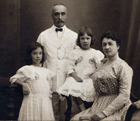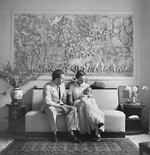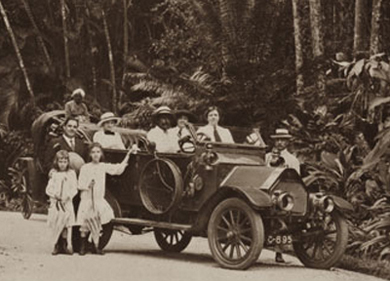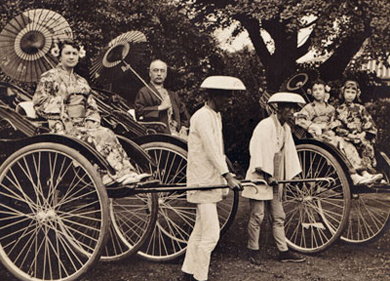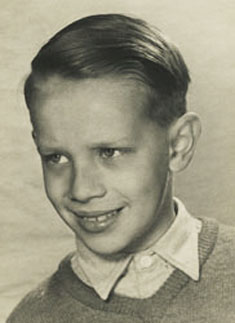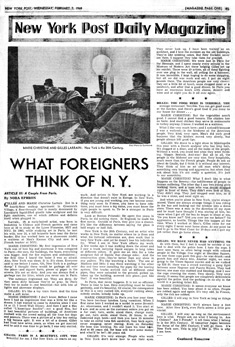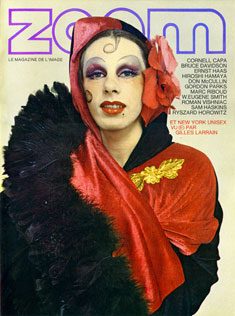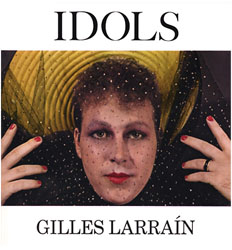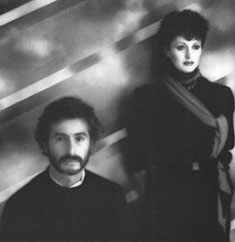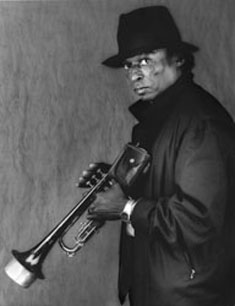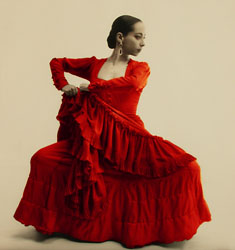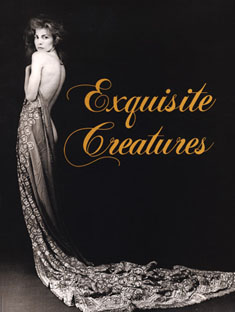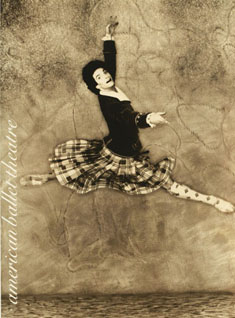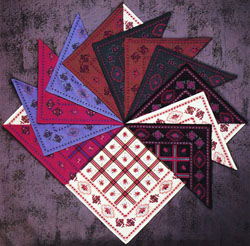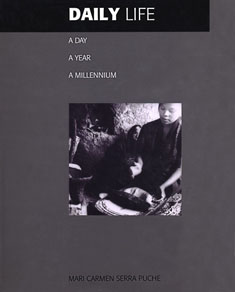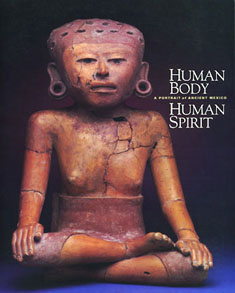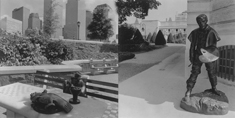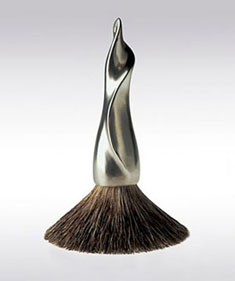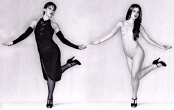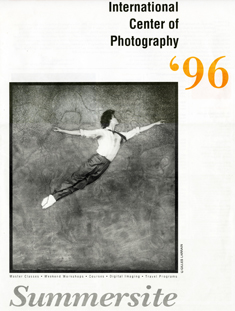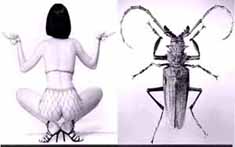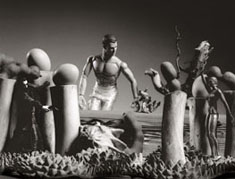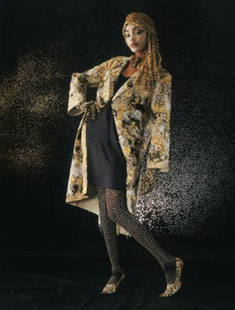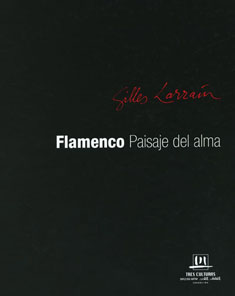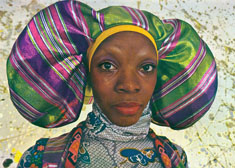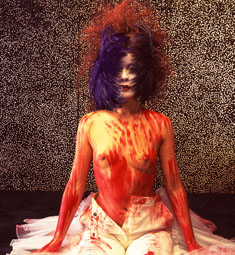Gilles Larrain Biography
By François-Dominique Armingaud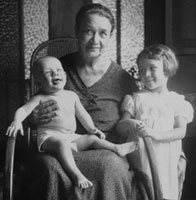 Gilles and Monique Larrain with
Gilles and Monique Larrain withGrandmother Alice Blanchy
Gilles Larrain was born in Dalat, Indochina, in 1938 to a Chilean father, who was a diplomat and painter, and a French-Vietnamese mother, who was a pianist and painter. His father was Hernan Larrain, at that time consul of Chile in Indochina, and Charlotte Mayer-Blanchy, granddaughter of Saïgon’s first mayor Paul Blanchy. He was also the nephew of cardinal of Talca (Chile) Rafaël Larrain. He was educated at New York University and at the Ecole Nationale des Beaux-Arts in Paris where he studied architecture and worked in city planning.
Since 1969, Larrain has devoted his energies to photography and has concentrated specifically on portraiture. In 1973 he published the highly successful photographic book Idols, which presented portraits of transvestites. Larrain sees portraiture as a way to “capture the landscape of the soul of a person”. His subjects have ranged from dancers to musicians, artists, celebrities and friends.
In 1983, he planned to visit Spain for a couple of weeks and ended up staying more than two months. Captivated by the flamenco aesthetic, Gilles became a great follower of this art. His camera has captured the soul of flamenco in one of those rare artistic conjunctions where technical wisdom and experience become melded with the most difficult to express emotions.
The Youth Years – Photos
Landmarks in the world
Following his family through his father’s assignments, Gilles will live after his Dalat years in Santiago (Chile), Buenos Aires (Argentine), Paris (France), New York City (USA), Montreal (Canada) and again Paris. The effort to adapt every time to new class comrades with a new culture and a new language will prove fruitful in giving him an insight to both what is common and what is specific everywhere.
Though his father was also a painter, and his mother Charlotte both a pianist and painter, Gilles had undertook a mainstream classical education. He got excellent results in the Lycée français of New York, part of his motivation being to jump one full year in order to attend the same course than a young girl named Anne-Marie Maluski. (not only did he succeed, but he eventually married her). Having as a consequence a wide career choice, he first made a short stay at M.I.T., then went to New York University, and finally to the Ecole des Beaux-Arts in Paris to study architecture(1) and city planning.
Throughout this period Gilles’s passion and commitment to painting and drawing was a parallelactivity. Culminating in his first one-man show in New York in 1966.
Gilles’s First Exhibition – Photos
Paintings by my Father – Photos
1963 : The Mexico travel study
During a travel study in Mexique in 1963, he realized, with a mere Nikon Parallax, that while architecture was partly designed to create emotion (otherwise why bother to design beautiful edifices ?), pictures were able to considerably magnify that emotion when directed by a lover’s eye.
There was a kind of mystery here – Architecture created(and that was its glory) under the weight of formidable constraints which were gravity, materials resistance, functional space needs and light, while pictures were to the former M.I.T. student merely enslaved to the geometry of light. How the latter could therefore create similar emotions appeared to be a deep enigma.
Van Gogh had of course already supplied a key here while showing how constructions as commonplace or even ugly – as the Eglise and Mairie of Auvers-sur-Oise could become things of beauty when seen with uncertain regard.
Moreover, where architecture may allow masterpieces to be created, city planning is inherently unable to do so in any way, because the fate of a city is to be constantly redesigned to face always changing conditions. The work of a city planner is therefore, and paradoxically, more ephemerous that the work of an artist which is supposed to stay unchanged forever when its author has given it its final touch(2).
Larrain dates from that moment his decision to become an architect of image, an architect of the immaterial(3). As a side effect of this conversion, there would be no more interference of financial or organizational details between what Gilles had in mind and what he would be allowed to realize. “Gershwin said that creation meant 5% of inspiration and 95% of perspiration”, he said. “We all agree with that, but not with creation meaning 20% of ideas and design for 80 % of political manoeuvering and business dealings; having little patience with both, I decided to have more control on my own destiny. I did not like the office work; I did no like working in groups where business is the purpose“.
The research years : 1967-1972
Though photography was the reason why he stopped getting involved with architecture, Larrain began by tackling with other forms of visual arts/ His beginnings will consist of three major steps :
- His paintings will explore the space of shapes, colours and materials.
- His kinetic art will explore the space of light and volumes(1), mostly through neons and inflatable structures. He exposes at the fifth Biennale de Paris (“Espaces dynamiques en constant mouvement“) and will be decerned in 1969 – sixth Biennale – the Less Levin prize with François Dallegret for their common work Tubalair.
- Last but not least, his early photographs will among other things make a still by nature – evocation of movement ( Landscapes ). This idea will culminate in his later Dance and Flamenco series.
1968 : New York Post Daily Magazine – What Foreigners Think of New York
A Couple From Paris.
By Nora EphronGilles and Marie Christine Larrain live in a fourth-floor walkup apartment in greenwich Village, a floor-through that is mostly dominated by Larrain’s liquid-filled plastic tube sculpture and his light machines, one of which inflates and deflates itself when plugged in.
larrain, 29, a curly-haired artist, was born in Indochina to Chilean and French parents and came here at 16 to study at the Lycee Francaise, MIT and NYU. in 1965, while stdying art in Paris, he met his wife, now 24, a tall brunette born near the Swiss border. She has worked here as a showroom modelm a waitress at Max’s kansas City and now is a French teacher at NYU…
The Memory years 1973-1985
1972 : Zoom Magazine – Photos
New York vit à l’heure de la féte. Une féte que nos yeux europeens savent mal déchiffrer aujourdʼhui, puisque nous ne verrons souvent que provocation, outrance et ridicule là où s’expriment, avec une déconcertante affirmation ludique, les premiers soubresauts d’une nouvelle liberation : The Gay Lib. Aprés les femmes et le Women’s Lib, les homosexuels (en anglais : gay) ont decidé de remettre en cause, avec leurs propres armes, l’oppression dont est objectivement victime une espéce que la majorité silencieuse a longtemps condamnée : la société marginale des homosexuels, transexuels ou travestis. Ceux qui ne correspondent pas au “modèle dominant”, ces avant-deniers métèques pour qui aucune Terre Promise ne se dessine à l’horizon de nos mondes dits civilisés. A New York, il y a aussi Gilles Larrain, photographe, architecte, cinéaste. Depuis un an, son studio est ouvert en permanence à cette faune exubérante, aux Cockettes et autres “beaux monstres” (beautiful freaks ) qui ont pris la tête du Mouvement et redecouvrent, tres simplement et tres instinctivement, les vertus libératrices du spectacle et de la représentation. Ces documents dont toute ironie est exclue — si ce n’est celle qu’exprime le modele lui-même – ne sont pas ceux d’un moraliste ou d’un bateleur avide d`exploiter ces phénomènees épate-bourgeois. Et sʼil fallait définir cette expérience que Gilles Larrain conduit avec sérénité depuis plus de douze mois, ce n’est pas au vocabulaire du critique d’art qu’il faudrait faire appel mais bien aux notions les plus resolument modemes et salutaires de l’antipsychiatrie.
Michel Caen
1973 : Idols – Photos
Larrain’s first album, Idols (1973), caused quite a stir when it was issued. The album is devoted to the Cockettes, a gay activist group of about 150 people(2), who intend to invent their lives without reference to the choices Mother Nature made for them, a mainstream subject nowadays, but still somehow sulfurous in the early seventies.
Gilles, who met them at Max’s Kansas City, is at that time interested in these young people who choose to be architects of their own bodies, look and life style. He decides to mark their radicalism by colourlful emphasis of their difference : forget pastel shades, soft lights or delicate manierism ! The album will encounter success, but the Cockettes themselves will not share that enthusiasm, thinking they have been used as mere raw material. “They were not.”, Gilles said, “However one should be prepared to see oneself with other eyes than one’s own. This is their lives, but the glance I lay on them is mine” and is not the one they were expecting.
Beware of the Queen’s wrath when her mirror does not tell her what she wanted to hear(3).
1981 : Portraits – Photos
After the colourful experience of Idols, Gilles will take the opposite direction : Portraits (1981) in black and white. Here again, the experience of coming to Gilles’ peculiar studio is an important part of preparation : when, just by pushing a door in the center of Soho, you find yourself in a place having 7 meters of height between floor and ceiling, three intermediate floors, no windows showing anything of the outside world, and are surrounded by giant photographs, you have the feeling of entering a kind of parallel universe where none of your currents landmarks (daylight, sky, scales, familiar objects…) is there to help you. That is precisely what Larrain is looking for.
1983 : An obsession for control – Photos
Larrain will keep this obsession of control during all his career : except naturally for landscapes and Flamenco, all of his photographs will be taken in his studio, and he will insist on mastering the whole photographic chain from the camera up to and including the dark room. For his Portraits, he did not go and meet his models in their own environment. They came to his studio and had to adapt to it, their adaptive reaction being part of what the photographer was seeking.
Sometimes, things would be unexpectedly difficult. This was the case when Miles Davis came for his photo session during the hot end of May 1983) when Gilles’ air conditioner was out of order ! That did not prevent the series to be one of the most successful ones : Miles insisted with CBS records that Gilles’s photographs should be the one used as the cover of his album Decoy.
Important warning : As most of Gilles’ works are more or less entangled in time, all the dates given hereunder will refer to years where a given style was clearly dominant in his creations. They do not mean he did not work on other things, nor that he did not tackle at all with the corresponding concepts at other dates.
1983 : Flamenco – Photos
Flamenco (1983) will take its roots both in the colourlful experience of Idols and in the inner life research characteristic of Portraits. It is to be noted that Gilles is not only a flamenco listener : he is also an excellent flamenco guitar player, who gave a series of public concerts all of them fully booked in New York. “Flamenco is the soul of a people”, he says, “at the confluent of many musical and emotional influences in Andalusia. Even though Franco hated flamenco music, he had no choice but to tolerate it, because Spain without Flamenco would not be Spain anymore. Everything I had to do was to reflect as faithfully as possible the way I experienced that music and life style from the inside”.
That series will close the circle of experiments around light before the artists listens for a while to the sirens of Madison Avenue, and then enters a photographic exploration of conceptual art that mattered so much to him in his kinetic arts years.
Gilles Larrain went on a two-week trip to Andalusia in 1983 to photograph flamenco for GEO magazine. He ended up staying for two months in the attic of La Carboneria—a flamenco venue in Seville — as guest to the owner, Paco Lira, a kind of godfather to the flamenco world. The photos of “flamenco: Landscapes of its Soul” are the result of Gilles’ endless nights at the Carboneria and his trips with Paco to the homes of some of flamenco’s legendary families. Others were taken at Gilles’ SOHO studio where he continues to photograph flamenco artists that come to New York. Gilles’ one-of-a-kind gelatin silver prints document major contemporary flamenco artists off stage in intimate settings. His photos capture the privileged studio moment and explore the visual aesthetics of flamenco that reflect the austere beauty of the Andalusian landscape. Through Gilles’ lens, we enter the inner circle of families and catch a glimpse at the hidden world where flamenco exists for its own sake, where spontaneous outbursts of song, dance and guitar playing are intermingled with the daily course of life. A flamenco guitarist himself, Gilles has hosted countless flamenco or jam sessions at his SOHO studio where he invites musicians from all over the world. Gilles prints all of his photographs himself in series of very limited editions. “Flamenco: Landscapes of its Soul” is a work-in-progress. Gilles plans on photographing more flamenco artists in Spain and at his studio in New York for the future publication of a book.
Trina Bardusco, 2001 – Flamenco: Landscape of its Soul
1985 : Exquisite Creatures – Photos
In the contemplation of nudes, we congratulate ourselves upon the beauty of which humans beings are capable. They reassure us about ourselves, about Being. We are a little lower than the angels, true, but notice that we can get along without that suspect radiance, equal parts paint and literature, on which the angels lean so heavily. The human body is, or can be, a sufficiency.
Gilles Larrains’s images offer a contemplative view of the nude. The young woman with her hands folded between her legs is thinking, questioning the camera (as her interrogatory gaze makes clear). As on others of these pictures, there seems to be an uneasy truce between subject and photographer–almost-but-not-quiet argument, contention, testing. The photographer achieves the image with some degree of mental effort. In another shot, three women epitomize not boldness but bravery. All are heavily laden with jewlery: necklaces, earings, bracelests, pearls, bangles. There are ruffled skirts, a feather boa on the one at the left, rings, watches, petticoats, the whole armorium of allure is represented. The scene is one, finally, of a war party getting ready for a raid, bursting with intelligence, strength, and joie de vivre.
Larrain manages to locate, in all his photographs, bits of the subversive. in another shot the subject, in profile with her hands clasped on top of her head, has moved just as the shutter was released, giving a stroboscopic flutter to the hands, a slight shimmer around the head and arms. The white of the head, shoulders, and arms contrast shaply with the clack velvet of her dress (the pose is reminiscent of Sargent’s famous Madame X, although the model is facing in the opposite direction). It’s a strategy disquieting picture, its strong formal values set over against the irruption of accident, with estmable results.
– DONALD BARTHELME
An atypical experience with Robert Mapplethorpe, Deborah Turbeville and Roy Volkmann will lead to Exquisite Creatures (1985, William Morrow and Company, Inc, New York, New York), a black-and-white symphony around the many aspects of femininity, opened with a score of Larrain’s photographs expressing his inner world.
1985 : American Ballet Theater – Photos
In 1985 Gilles was comissioned by Mikhail Baryshnikov to photograph the American Ballet Theater souvenir book. The 89 members of the corps de ballet and the principals came to the studio in SoHo to be photograph against a large backdrop canvas painted by Gilles.
1986 – 2006 : More flirting with advertising world
What did Gilles do between 1985 and 1995 ? He smoked pot with friends. He drank. He went to the dentist. He divorced of his second wife, Christine, while trying to preserve teir daughter Olivia of too harmful collateral damage. Basic operations of an artist between two phases of his work. Also, he indulged in the sweetness of advertisements for Pierre Deux (1985-1986), GTE (1987), Knoll International, and Joel Name, a collaboration he will keep from 1984 to 2003.
1990 : The Meadows Museum, Dallas, Texas
The Meadows Museum is pleased to offer this exhibition of new work by the artist Gilles Larrain. The exhibition continues our examination of contemporary art with distinctly Spanish influences and its relationship to the Algur H. Meadows Collection of Spanish Art, which forms the core of Meadows Museum.
The exhibition Mirrows of Memory: Photo Icons by Gilles Larrain represents at least the third twist in the artist’s career. After his academic training at the Ecole Nationale des Beaux-Arts in Paris, Larrain worked in city planning. His entree to the art world was in the 1960s as an environmental sculptor whose materials were air, smoke, light, water, and neon tubes. He next became known for his book IDOLS (1973), a collection of brightly colored dramatic photographs of transvestites. Then, after several years of traveling in what appeared to be one direction, documenting the very edge of society, Gilles suddently revived the social portrait, with straightforward soft, black and white portrait of friends, celebrities, artists, and professional models taken in his New York SoHo studio on Grand Street. A series of these portraits can be seen in the work title Windows of Opportunity.
Now, in another dramatic twist, Gilles is pluming the depths of his extensive archive of photographic images to create objects incorporating photographs, canvas, and paint, which he calls photo icons. These objects lie in the increasingly hazy ground between photography and painting. One essential difference between photography and paintings is the photographer’s reliance on the mechanical device of the camera as compared with painter’s hand-to-brush technique. Both rely on mechanical extensions to produce the work, the simple brush and extension of the hand, and the camera, increasingly complex, an extension of the eye. In Larrain’s icons these disciplines are merged in a single object.
There is an interesting, almost nineteenths-century romantic look about several of the photo icons in this exhibition. Adonis and the Seduction of Eloquence and The Uses of Enchantment, two early, related works in this series, have as their subject a dancer whose photographed image resembles the models in nineteenth-century anatomy studies. Taking their inspiration from classical subjects, both icons have a finished quality more antique than modern. In Leaves of Hypnos, a study of a monument in florida, the painted elements are very modern although the overall effect is antique, and Three Trees resembles early hand-painted photographs.
Taken over a period of time, generally in his studio, Larrain’s photographs are at the core if these new iconic works. As images and symbols of contemporary international community, the photographs are used here in a narrative fashion, to portray the emotions rather than the incidents of our society. Perhaps they may help us to regard all photographs not as mere documents of a time and place but as mediums for an emotional message from the artist.
Donald E. Knaub – Director
1993 : Daily Life – Photos
“When one loves life, one loves the past, for it is the present as it has survived in the collective memory of mankind.”
– Marguerite Yourcenar
1993 : Human Body – Human Spirit – Photos
In certain contemporary indigenous cultures of Mexico and the Central America, such as the Mamspeaking Maya, the sense of self does not stop with the body. Members of a community share a community soul in addition to possessing an individual greater access to ritual “heat” or fiery knowledge and power. People define themselves primarily in terms of their community, its lands, ancestors, and traditions. These people also share the reality of dreamtime. Their “deaming bodies,” alternate selves, may meet in dreams where their actions decide the fates of the indiviuals, only to be acted out while awake. Alternatively, the ancestors may speak to people in dream, teaching important traditional skills and ritual behavior.
1995 : Foray into conceptual art : Paris-New York
In 1995, Gilles realizes thirty diptychs for an exhibition called Paris-New York. Each of them juxtaposes accidental dichotomy between separate photographs of each city discovering unexpected relationshionships between them.
In the words of Jean-Marc Huitorel, the director of the exhibition, “What most of Gilles Larrain’s works reveal is their aptitude to show similarities. Diachronic similarities between ancient imagery of madones and contemporary standards (of portraits or nudes), synchronic similarities between figures of modern dance and archetypes of classical beauty”
1995 : Conceptual advertisement – Photos
Larrain will accept one last campaign of advertisement, about a product called ê-Shave, because he both likes the product and the way it is designed. “When art can help to promode beauty, it is a synergy you just cannot refuse”, he says.
After that, one will also see in an advertisement a part of his work that was never intended for that purpose : X. will use one of his Flamenco photographs as a last cover of Popular Photography Magazine in August 2006.
1996 and onward : The conceptual years
The later years of Larrain’s works seem inspired by what mathematicians call the Radon Theorem. That theorem states that an entire object can be reconstituted from an appropriate set of its projections. Gilles replaces the this physical projection with conceptual projection as the key idea in his ongoing series : Twins and Diptychs.
1996 : Twins – Photos
In Twins, two separate images of the same subject are shot-dressed and naked in the same position. Herriot said : “Culture is what is left when you have learned and then forgotten everything” Here, the subject’s nature is described by what remains when they take off everything that describes them socially but not adopting the other codes, just as constraining though more subtle, related to nudity.
“An interesting thing”, Larrain says, “is that a truly identical posture is never completely possible. The spectator with a trained eye will notice tiny modifications of face traits and muscles tension that hint at the unease of the situation-the absence of the clothes that renders them vulnerable while being observed would allow and justify it”. Of course, this is not to be intended as a “find the errors” game : checking these details one by one would loose the magic just as if you were to count spots in a Seurat painting! These photographs transmit an almost surrealistic message – one that appeals to the subconscious in a very deep manner.
1996 to 2005 : The Teaching Years at the International Center of Photography
The Art of Portrait Photography and The Intimate Portrait
Taught on location at Gilles Larrain’s downtown studio, this workshop will explore the art of portrait photography. For over two decades, Larrain has photographed a wide range of subjects, from the music world (Nina Hagen, Miles Davis) to the dancers of the American Ballet Theater (Robert La Fosse, Mikhail Baryshnikov) and intimate portraits of his friends and family. In this class, students will choose their own lighting techniques and setup arrangements and direct the models. Through this process, they will be able to gain an insider’s understanding of how it feels to be the ” subject” and the type of relationship that can evolve in a playful session between photographer and models. Students will work with medium format cameras (2 1/4″), to examine the suitability of the large negative for portraiture. Students will photograph in black-and-white and color.
Gilles Larrain, Photographer specializing in fashion, portraiture, and landscape; exhibited extensively in the US and Europe; publications include Profoto; The Book of Flash and A Portrait of ancient Mexico Human Spirit
1999 : Diptychs – Photos
Diptychs take the opposite side of the same coin. Instead of having the same model with and without clothes to separate the human soul from the material accessory, it puts into light uncanny similarities of shapes between totally different one would think photographs, suggesting some unknown universal (mathematical ?) rules to which seemingly different subjects would obey. One could describe it as a visual presentation of Jung’s synchronicity concept.
2002 : Dark Angels – Photos
The events of 9/11 and onward will incite Gilles to revisit one of his ideas dating back to 1996 and unexploited by him at the time : are there dark forces surrounding us ? Could our collective inconscious be a part of these, just like it was for Dr Morbius in the movie Forbidden Planet? How to symbolize the hidden fantasies around us and sometimes even in us?
2005 : The Fashion World – Photos
From the beginning Gilles resisted entering into the fashion world of photography. For Gilles fashion seemed to superficial and of little interest for his conceptual concepts and ideas. Slowly seduced by a project for Pop Magazine ( a fashion shoot ) and by the creative world and energies of Louda’s fabrics, textiles, and artwork Gilled finally gave in and jumped headfirst into the water.
2006 : Flamenco Paisaje del Alma – Photos
Para la Fundación Tres Culturas del Mediterraneo es un honor poder presentar la exposición “Flamenco, paisaje del alma” del fotógrafo Gilles larraín, parte fruto de un viaje que Gilles realizó en los primeros años ocheanta a AndalucÍa y parte resultado del trabajo realizado durante años en su estudio neoyorquino barrio del SoHo, por donde regularmente pasan las figuras consagradas y los jóvenes valores del flamenco con ocasion de sus visitas a la Gran Manzana
Es Gilles un personaje interesante y contradictorio, como la ciudad misma que eligió hace ya más de tres décadas para desarrollarse personal y profesionalmente. Desde su nacimiento fue Gilles eso que se conoce como “ciudadano del mundo”: de orígenes franco-chileno-vietnamitas, desde muy joven buscó, en diferenter lugares y con avidez casi desesperada, la belleza original, la auténtica se diría también, siempre tan dificil de hallar, y que él intentó encontrar primero en la arquitectura y la pintura -objeto de sus primeros estudios- y hallándola finalmente, creo, en sus dos grandes pasiones, la fotografia y el flamenco.
En nueva York trabajó con los grandes iconos del arte y la cultura de los vertiginosos años setenta y ochenta: Mapplethorne, John lennon, Miles Davis y muchos otros. En su ya citado viaje a Andalucía y durante sesiones en su estudio en los noventa y los primeros años de 2000 realizó las fotografias que hoy conponen esta exposición. Con todos desarrolló Gilles esa única forma de trabajar que combina la perfeccion técnica y la complicidad personal con el retrato y que resulta en obra artistica de gran belleza y originalidad. Con todos sus retratos consigue Gilles -¡nada menos!- superar la afirmación de Kafka de que el retrato fotográfico no hace sino mostrar simplificadamente la superficie plana de las personas, ocultando la iqueza interior de los seres humanos. grasias a Gilles podemos hoy apreciar no solamente los rostros y figuras de la Prerrata, el Lebrijano, el Cabrero, la Yerbabuena o el Pipa, sino también su duende, esa riqueza interior y profunda que el escritor de Praga tanto echaba de menos en el entonces joven arte de la fotografia
Con “Flamenco, paisajes de alma”, la Fundación Tres Culturas participa por primera vez en la Bienal de Flamenco de Sevilla, para itinerar, posteriormente, por otros lugares de Andalucia, del Mediterráneo y América, contribuyendo con estas fascinantes fotografías de Gilles Larraín el mejor conocimiento de un arte al mismo tiempo tan andaluz tan universal.
Enrique Ojeda Vila – Director Gerente de la Fundación Tres Culturas del Mediterráneo
2010 : Vice Magazine
I can’t remember when I first saw the book Idols by Gilles Larrain. All I know is that ever since I got it, it’s been a huge influence on me. Idols is one of the best photography books I’ve ever seen. It was published in 1973 and it’s a collection of studio portraits of trannies, gender-benders, and just generally awesome-looking people in New York City. It’s an incredible time capsule. There are Warhol people, like Taylor Mead and Holly Woodlawn, and members of the San Francisco–based psychedelic drag-queen performance troupe the Cockettes. There’s a photo of the artist Al Hansen, aka Beck’s grandfather, covered in silvery paint and dressed up like some kind of Roman soldier, and an unrecognizable teenage Harvey Fierstein, looking like a young pretty Jewish lady (well, almost). Most important, these people all had the best style. The greatest fashion always originates with drag queens. The outfit you’re wearing today was probably invented by a drag queen ten years ago.
– RYAN MCGINLEY
2010 : S Magazine – Photos
Some photography deserves words to go along with it. When the great photographer Gilles Larrain decides to shoot a subject who is as intriguing as the actress and dancer Miho Nicaido, commentary is in order, because it is not every day that two very authentic art icons free of faddishness; free of fraudulence meet, elevate each other’s virtues, and thus elevate the craft of portraiture. For this exclusive shoot, which took place in New York’s SoHo neighborhood in late 2009, S Magazine and its readers are particulary privileged.
J.P.T, Molyneux – S Magazine (February 2010)
An atypical session
This biography would not be complete without a mention about one of the times Gilles did not undertake a photography session in his Grand Street studio. He had an excuse for that, tough, because the art pieces he photographed were in the Vatican gardens in 1983 and could not be moved. In fact, they were so closely watched that one had to get one separate authorization for each thing to be photographed and each angle under which they had to be photographed. Gilles began to worry about the formidable paperwork that would require :
- I am only here for two weeks !
- My son, this is of no concern to us. This house has existed for twenty centuries, and we have eternity in front of us. First show me your passport, please.
Gilles showed his French passport.
- Larrain ? This is not a french name. Isn’t it Chilean ?
- or exactly Basque.
- Who was Rafael Larrain?
- My uncle. Oh, by the way, he was a cardinal here in the latter part of his life.
The man smiled
- Well, my son, as you are somehow part of the House, I shall give you a blank authorization to photograph everything you want under any angle you wish.
- 1 Among other masters, he will quote Mies van der Rohe and Marcel Breuer
- 2 Interesting counterexamples are the caves ol Altamira (Spain) and Lascaux (France) who kept unchanged both their architecture and paintings for thousands of years and not art dealers in the way !
- 3 Only decades later will he remember the following enlightening words, praised by Umberto Eco :
« It was a presentiment that human thought, in changing its form, was about to change its mode of expression; that the dominant idea of each generation would no longer be written with the same matter, and in the same manner; that the book of stone, so solid and so durable, was about to make way for the book of paper, more solid and still more durable. In this connection the archdeacon’s vague formula had a second sense. It meant, “Printing will kill architecture.” (…)
From the moment when architecture is no longer anything but an art like any other; as soon as it is no longer the total art, the sovereign art, the tyrant art,–it has no longer the power to retain the other arts. So they emancipate themselves, break the yoke of the architect, and take themselves off, each one in its own direction. Each one of them gains by this divorce. Isolation aggrandizes everything. Sculpture becomes statuary, the image trade becomes painting, the canon becomes music. One would pronounce it an empire dismembered at the death of its Alexander, and whose provinces become kingdoms. (…)
This does not mean that architecture will not still have a fine monument, an isolated masterpiece, here and there. We may still have from time to time, under the reign of printing, a column made I suppose, by a whole army from melted cannon, as we had under the reign of architecture, Iliads and Romanceros, Mahabâhrata, and Nibelungen Lieds, made by a whole people, with rhapsodies piled up and melted together. The great accident of an architect of genius may happen in the twentieth century, like that of Dante in the thirteenth. But architecture will no longer be the social art, the collective art, the dominating art. The grand poem, the grand edifice, the grand work of humanity will no longer be built: it will be printed ». (We would say now : immaterial)
— Victor Hugo, Notre-Dame de Paris (Book Fifth: Chapter II. This will Kill That)
- 1 About his kinetic art years, Frank Popper in “Art, action and participation” says:
- 2 Among them, Harvey Fierstein, author of the comedy La Cage aux folles.
- 3 Following that album, Jean Lallement and Marc Pampusach (Publicis/Renault) ask Gilles whether he would accept to make a series of photographs for Club Med’s Trident magazine. He accepts and will also be in charge for Club Med’s advertisements for the five following years.
- 4 This idea would also be used in Len Deighton’s The IPCRESS file, and of course in the cult series The Prisoner.
“One cannot omit the realizations of Christo, H.W. Müller and Gilles Larrain [Christo was already known for his packaging ideas, Müller for his inflatable theater : the pneumatic structures of Gilles Larrain (…) allowed spectators to feel insolite spatial feelings”
